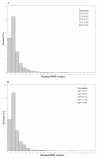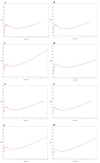Childhood body mass index trajectories: modeling, characterizing, pairwise correlations and socio-demographic predictors of trajectory characteristics
- PMID: 22458308
- PMCID: PMC3375197
- DOI: 10.1186/1471-2288-12-38
Childhood body mass index trajectories: modeling, characterizing, pairwise correlations and socio-demographic predictors of trajectory characteristics
Abstract
Background: Modeling childhood body mass index (BMI) trajectories, versus estimating change in BMI between specific ages, may improve prediction of later body-size-related outcomes. Prior studies of BMI trajectories are limited by restricted age periods and insufficient use of trajectory information.
Methods: Among 3,289 children seen at 81,550 pediatric well-child visits from infancy to 18 years between 1980 and 2008, we fit individual BMI trajectories using mixed effect models with fractional polynomial functions. From each child's fitted trajectory, we estimated age and BMI at infancy peak and adiposity rebound, and velocity and area under curve between 1 week, infancy peak, adiposity rebound, and 18 years.
Results: Among boys, mean (SD) ages at infancy BMI peak and adiposity rebound were 7.2 (0.9) and 49.2 (11.9) months, respectively. Among girls, mean (SD) ages at infancy BMI peak and adiposity rebound were 7.4 (1.1) and 46.8 (11.0) months, respectively. Ages at infancy peak and adiposity rebound were weakly inversely correlated (r = -0.09). BMI at infancy peak and adiposity rebound were positively correlated (r = 0.76). Blacks had earlier adiposity rebound and greater velocity from adiposity rebound to 18 years of age than whites. Higher birth weight z-score predicted earlier adiposity rebound and higher BMI at infancy peak and adiposity rebound. BMI trajectories did not differ by birth year or type of health insurance, after adjusting for other socio-demographics and birth weight z-score.
Conclusions: Childhood BMI trajectory characteristics are informative in describing childhood body mass changes and can be estimated conveniently. Future research should evaluate associations of these novel BMI trajectory characteristics with adult outcomes.
Figures



References
-
- Guo SS, Wu W, Chumlea WC, Roche AF. Predicting overweight and obesity in adulthood from body mass index values in childhood and adolescence. Am J Clin Nutr. 2002;76:653–658. - PubMed
-
- Raitakari OT, Juonala M, Kahonen M, Taittonen L, Laitinen T, Maki-Torkko N, Jarvisalo MJ, Uhari M, Jokinen E, Ronnemaa T. et al.Cardiovascular risk factors in childhood and carotid artery intima-media thickness in adulthood: the Cardiovascular Risk in Young Finns Study. JAMA. 2003;290:2277–2283. doi: 10.1001/jama.290.17.2277. - DOI - PubMed
Publication types
MeSH terms
Grants and funding
LinkOut - more resources
Full Text Sources

